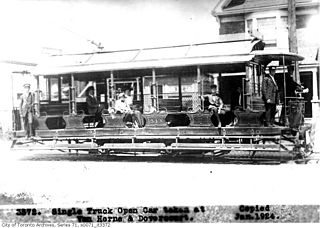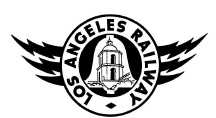Related Research Articles

The Pacific Electric Railway Company, nicknamed the Red Cars, was a privately owned mass transit system in Southern California consisting of electrically powered streetcars, interurban cars, and buses and was the largest electric railway system in the world in the 1920s. Organized around the city centers of Los Angeles and San Bernardino, it connected cities in Los Angeles County, Orange County, San Bernardino County and Riverside County.

The interurban is a type of electric railway, with tram-like electric self-propelled railcars which run within and between cities or towns. The term "interurban" is usually used in North America, with other terms used outside it. They were very prevalent in many parts of the world before the Second World War and were used primarily for passenger travel between cities and their surrounding suburban and rural communities. Interurban as a term encompassed the companies, their infrastructure, their cars that ran on the rails, and their service. In the United States, the early 1900s interurban was a valuable economic institution, when most roads between towns, many town streets were unpaved, and transportation and haulage was by horse-drawn carriages and carts.
The New York and Harlem Railroad was one of the first railroads in the United States, and was the world's first street railway. Designed by John Stephenson, it was opened in stages between 1832 and 1852 between Lower Manhattan Island to and beyond Harlem. Horses initially pulled railway carriages, followed by a conversion to steam engines, then on to battery-powered Julien electric traction cars. In 1907, the then leaseholders of the line, New York City Railway, a streetcar operator, went into receivership. Following a further receivership in 1932, the New York Railways Corporation converted the line to bus operation. The Murray Hill Tunnel now carries a lane of road traffic, but not the buses.

The Toronto Railway Company (TRC) was the operator of the streetcar system in Toronto between 1891 and 1921. It electrified the horsecar system it inherited from the Toronto Street Railway, the previous operator of streetcar service in Toronto. The TRC was also a manufacturer of streetcars and rail work vehicles, a few of which were built for other streetcar and radial operators.

New York State Railways was a subsidiary of the New York Central Railroad that controlled several large city streetcar and electric interurban systems in upstate New York. It included the city transit lines in Rochester, Syracuse, Utica, Oneida and Rome, plus various interurban lines connecting those cities. New York State Railways also held a 50% interest in the Schenectady Railway Company, but it remained a separate independent operation. The New York Central took control of the Rochester Railway Company, the Rochester and Eastern Rapid Railway and the Rochester and Sodus Bay Railway in 1905, and the Mohawk Valley Company was formed by the railroad to manage these new acquisitions. New York State Railways was formed in 1909 when the properties controlled by the Mohawk Valley Company were merged. In 1912 it added the Rochester and Suburban Railway, the Syracuse Rapid Transit Railway, the Oneida Railway, and the Utica and Mohawk Valley Railway. The New York Central Railroad was interested in acquiring these lines in an effort to control the competition and to gain control of the lucrative electric utility companies that were behind many of these streetcar and interurban railways. Ridership across the system dropped through the 1920s as operating costs continued to rise, coupled with competition from better highways and private automobile use. New York Central sold New York State Railways in 1928 to a consortium led by investor E. L. Phillips, who was looking to gain control of the upstate utilities. Phillips sold his stake to Associated Gas & Electric in 1929, and the new owners allowed the railway bonds to default. New York State Railways entered receivership on December 30, 1929. The company emerged from receivership in 1934, and local operations were sold off to new private operators between 1938 and 1948.

The San Joaquin Valley Railroad is one of several short line railroad companies and is part of the Western Region Division of Genesee & Wyoming Inc. It operates over about 371 miles (597 km) of owned or leased track primarily on several lines in California's Central Valley/San Joaquin Valley around Fresno and Bakersfield. The SJVR has trackage rights over Union Pacific between Fresno, Goshen, Famoso, Bakersfield and Algoso. The SJVR also operated for the Tulare Valley Railroad (TVRR) from Calwa to Corcoran and Famoso.

The Illinois Terminal Railroad Company, known as the Illinois Traction System until 1937, was a heavy duty interurban electric railroad with extensive passenger and freight business in central and southern Illinois from 1896 to 1956. When Depression era Illinois Traction was in financial distress and had to reorganize, the Illinois Terminal name was adopted to reflect the line's primary money making role as a freight interchange link to major steam railroads at its terminal ends, Peoria, Danville, and St. Louis. Interurban passenger service slowly was reduced, ending in 1956. Freight operation continued but was hobbled by tight street running in some towns requiring very sharp radius turns. In 1956, ITC was absorbed by a consortium of connecting railroads.

The Market Street Railway Company was a commercial streetcar and bus operator in San Francisco. The company was named after the famous Market Street of that city, which formed the core of its transportation network. Over the years, the company was also known as the Market Street Railroad Company, the Market Street Cable Railway Company and the United Railroads of San Francisco. Once the largest transit operator in the city, the company folded in 1944 and its assets and services were acquired by the city-owned San Francisco Municipal Railway. Many of the former routes continue to exist into the 2020s, but served by buses.

Fresno Area Express (FAX) is a public transportation operator in Fresno, California. The system had over 100 buses, 1,606 bus stops, and 18 routes as of August 2022. In 2023, the system had a ridership of 8,973,000, or about 40,300 per weekday as of the third quarter of 2024. FAX fixed routes run as far south as Malaga to Valley Children's Hospital in the north. Lines also run as far east as Fowler Avenue in Clovis, and as far west as Hayes Avenue near Highway 99 in western Fresno.

The Los Angeles Railway was a system of streetcars that operated in Central Los Angeles and surrounding neighborhoods between 1895 and 1963. The system provided frequent local services which complemented the Pacific Electric "Red Car" system's largely commuter-based interurban routes. The company carried many more passengers than the Red Cars, which served a larger and sparser area of Los Angeles.

The Central California Traction Company is a Class III short-line railroad operating in the northern San Joaquin Valley, in San Joaquin County, California. It is owned jointly by the Union Pacific and BNSF Railway.

The Sacramento Northern Railway was a 183-mile (295 km) electric interurban railway that connected Chico in northern California with Oakland via the state capital, Sacramento. In its operation it ran directly on the streets of Oakland, Sacramento, Yuba City, Chico, and Woodland. This involved multiple car trains making sharp turns at street corners and obeying traffic signals. Once in open country, SN's passenger trains ran at fairly fast speeds. With its shorter route and lower fares, the SN provided strong competition to the Southern Pacific and Western Pacific Railroad for passenger business and freight business between those two cities. North of Sacramento, both passenger and freight business was less due to the small town agricultural nature of the region and due to competition from the paralleling Southern Pacific Railroad.

The Peninsular Railway was an interurban electrified railway in the U.S. State of California in the United States of America. It served the area between San Jose, Los Gatos, and Palo Alto, comprising much of what is today known as "Silicon Valley". For much of its existence it was a subsidiary of the Southern Pacific Railroad.

The International Railway Company (IRC) was a transportation company formed in a 1902 merger between several Buffalo-area interurban and street railways. The city railways that merged were the West Side Street Railway, the Crosstown Street Railway and the Buffalo Traction Company. The suburban railroads that merged included the Buffalo & Niagara Electric Street Railway, and its subsidiary the Buffalo, Lockport & Olcott Beach Railway; the Buffalo, Depew & Lancaster Railway; and the Niagara Falls Park & River Railway. Later the IRC acquired the Niagara Gorge Railroad (NGRR) as a subsidiary, which was sold in 1924 to the Niagara Falls Power Company. The NGRR also leased the Lewiston & Youngstown Frontier Railroad.

The Visalia Electric Railroad, a wholly owned subsidiary of the Southern Pacific Railroad (SP), began as an electric interurban railroad in Tulare County, in the U.S. State of California. The railroad was incorporated on April 22, 1904. Passenger service was discontinued in 1924, and the electrification was removed in 1944. Subsequent operation was by diesel locomotive. The railroad was closed in 1992.
The San Francisco and San Mateo Electric Railway (SF&SM) was the first electric streetcar company in San Francisco, California. The company was only in business for ten years, starting from 1892 until it was merged into the United Railroads of San Francisco (URR) in 1902.
For over two decades in the early twentieth century, streetcars served as the main mode of public transit in Reno, Nevada, United States. The system consisted of a streetcar network in the area of Reno and Sparks, Nevada, as well as an interurban line between Reno and the Moana Springs resort.

The San Jose Railroads was a street railway operator in San Jose, from 1912 until April 10, 1938
Streetcars in Redlands transported people across the city and region from 1889 until 1936. The city's network of street railways peaked around 1908 before the patchwork of separate companies was consolidated under the Pacific Electric.
References
- 1 2 3 4 Renovich, Steve (1960). "Fresno Traction". The Western Railroader. 23 (248). Francis A. Guido: 3–6.
- ↑ "Pacific City Lines Buys Fresno Traction Company Transportation System". The Fresno Bee. Fresno, California. March 21, 1939. pp. 1-A–2-A . Retrieved December 10, 2024– via Newspapers.com.

- ↑ Renovich, Steve (1960). "Fresno Interurban". The Western Railroader. 23 (248). Francis A. Guido: 15 & 16.